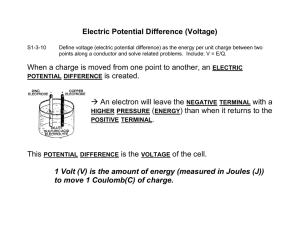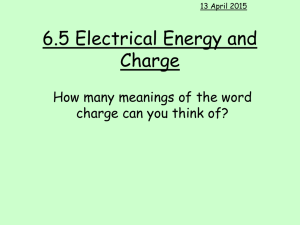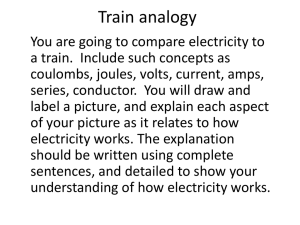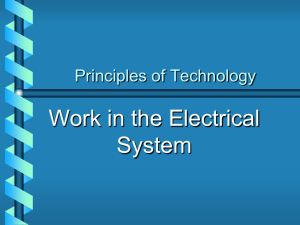2.3 Work in Electrical Systems
advertisement
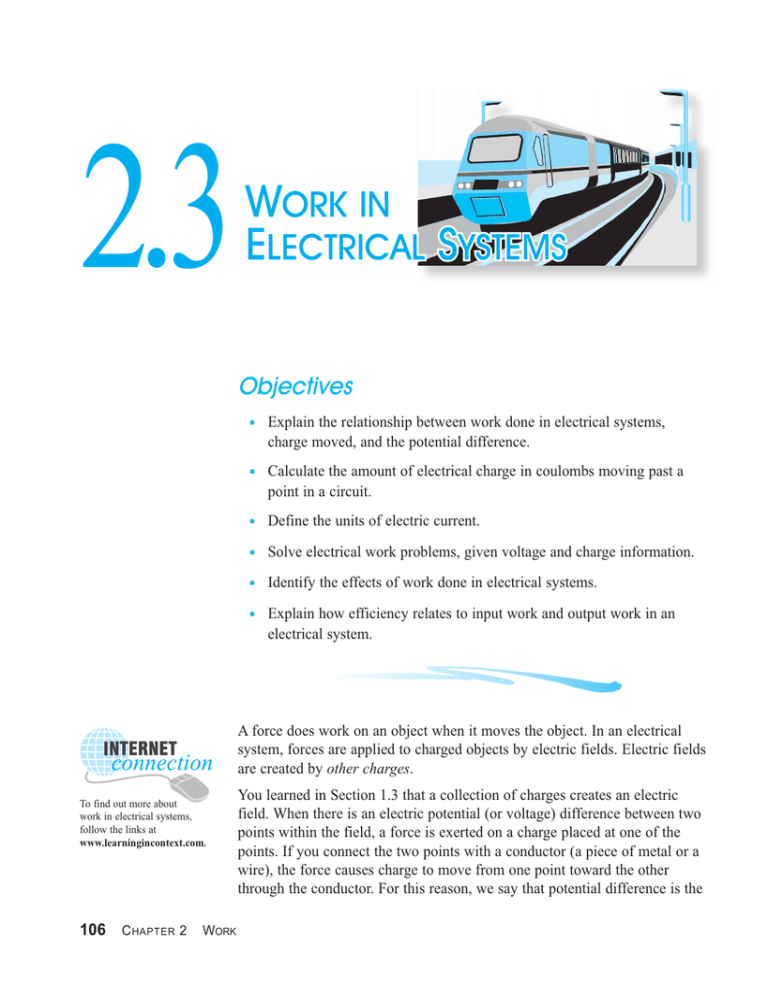
Objectives • Explain the relationship between work done in electrical systems, charge moved, and the potential difference. • Calculate the amount of electrical charge in coulombs moving past a point in a circuit. • Define the units of electric current. • Solve electrical work problems, given voltage and charge information. • Identify the effects of work done in electrical systems. • Explain how efficiency relates to input work and output work in an electrical system. A force does work on an object when it moves the object. In an electrical system, forces are applied to charged objects by electric fields. Electric fields are created by other charges. To find out more about work in electrical systems, follow the links at www.learningincontext.com. 106 C HAPTER 2 WORK You learned in Section 1.3 that a collection of charges creates an electric field. When there is an electric potential (or voltage) difference between two points within the field, a force is exerted on a charge placed at one of the points. If you connect the two points with a conductor (a piece of metal or a wire), the force causes charge to move from one point toward the other through the conductor. For this reason, we say that potential difference is the prime mover in electrical systems. Just as the presence of a pressure difference can result in a fluid moving and doing work in a fluid system, the presence of a potential difference can result in charge moving and doing work in an electrical system. Examples of electrical systems are shown in Figure 2.13. Notice that, in each example, you can’t see the electrical work being done. You can see (or hear or feel) only the results of electrical work—rotation, light, sound, heat—as electrical work is converted into other forms of energy. (a) To rotary mechanical (b) To light (c) To sound (d) To heat Figure 2.13 Converting electrical work to other forms of energy How Big Is a Coulomb? Batteries are sources of potential difference. In Figure 2.14 a battery is connected to a parallel-plate capacitor. The battery’s potential difference results in electrons moving from the top plate, into the battery, and onto the bottom plate. The bottom plate now has an excess of electrons stored on it and is negatively charged. The top plate has a deficiency of electrons and is positively charged. S ECTION 2.3 WORK IN ELECTRICAL SYSTEMS 107 Figure 2.14 A battery moves charge off one plate and onto the other. Electric charge is measured in coulombs (C). In Section 1.3, you learned that the elementary charge, or the charge of a single electron or proton, is 1.6 × 10–19 C. (An electron’s charge is negative and a proton’s is positive.) How many electrons are needed if one coulomb is deposited on the bottom plate? 1 electron N electrons = −19 1C 1.6 × 10 C N = 1 6.25 × 1018 electrons −19 = 1.6 × 10 One coulomb is equal to the charge of 6.25 × 1018 electrons. This is 6.25 billion billion electrons. 1 C = charge of 6,250,000,000,000,000,000 electrons Thus, a net charge of one coulomb represents 6,250,000,000,000,000,000 more electrons on the bottom plate of the capacitor than on the top plate. That’s such a large number that most of us can’t grasp its size. But we can develop an appreciation for this number by going through the following thought exercise. Think of an electron as a single grain of sand, approximately in the shape of a cube, 0.05 mm on a side. It would then take about 20,000 rooms, each 12 ft × 12 ft × 10 ft, filled with sand, to equal 6.25 × 1018 grains. That’s the same as the number of electrons that provide the charge equal to one coulomb. 108 C HAPTER 2 WORK Work in Electrical Systems In Section 1.3, you learned that, when a charge q is placed in an electric field E, a force FE is exerted on the charge. The relationship between these values is F E= E q For a positive charge, the direction of the force is the same as the direction of the electric field. You can solve this equation for force. The magnitude of the force can be found from the following equation: FE = E × q Figure 2.15 When a charge is moved in an electric field, work is done. Also from Section 1.3, the potential difference, or voltage difference ΔV, between two points A and B in a uniform electric field depends on the distance d between the points and the magnitude of the electric field. The relationship is ΔV = E × d The subscript used in Section 1.3 has been dropped. When the charge is moved from A to B, as in Figure 2.15, an outside force is applied, equal in magnitude but opposite in direction to FE. This force is applied over a distance d. Therefore, work W is done on the charge equal to the force times the distance. W = FE × d = (E × q) × d = (E × d) × q = ΔV × q Electrical work is the product of potential difference and charge moved. S ECTION 2.3 WORK IN ELECTRICAL SYSTEMS 109 Work = potential × charge difference moved W = ΔV × q As in mechanical and fluid systems, work in electrical systems is measured in newton-meters (N • m), or joules (J). Since potential difference is measured in volts (V) and charge is measured in coulombs (C), the equation above shows that one joule equals one volt • coulomb. 1J = 1V•C We can solve the work equation for the potential difference: ΔV = W q This equation shows a new meaning for voltage. If 1 J of work is required to move a charge of 1 C between two points in an electric field, the potential difference between the points is 1 V. 1V = 1 J C The derivation of the work equation used a positive charge being moved through a positive potential difference and resulting in positive work done on the charge. In general, charge can be either positive or negative; so can potential difference and, therefore, so can work. Remember, electric fields and potential differences are created when there is a separation of charge. By convention in science and engineering, electric field vectors always point in a direction away from the positive charge and toward the negative charge. This is illustrated in Figure 2.16 for the simple case of charged parallel plates with a uniform electric field between them. In the diagrams, point B is at a higher potential than point A. To see why, imagine placing a positive test charge at B. The charge will feel a force acting in the direction of the electric field. If the charge is released, it will accelerate toward A. Therefore, if a charge is moved from A to B, the change in potential, or potential difference, is positive. If the charge is moved from B to A, the potential difference is negative. 110 C HAPTER 2 WORK Figure 2.16 When a charge is moved in an electric field, W = qΔV. Work can be positive or negative. The diagrams show all four possible combinations of the signs of charge and potential difference. Since work is the product of charge and potential difference, two of the products result in positive work and two result in negative work. Example 2.8 Work Done to Charge a Battery An automobile battery is being charged. During the first 15 minutes of charging, 800 C of charge are deposited in the battery by an average potential difference of 8 V. How much electrical work is done by the charger during the first 15 minutes? Solution: W = ΔV × q = (8 V) (800 C) = 6400 V • C or 6400 J Therefore, 6400 J or 6.4 kilojoules (kJ) are required to recharge the battery during the first 15 minutes. Electric Charge and Current The amount of electric charge moved in a circuit can’t be measured easily in coulombs. It’s more practical to measure the rate at which charge flows, or S ECTION 2.3 WORK IN ELECTRICAL SYSTEMS 111 electric current. Current is measured in coulombs per second. A flow of one coulomb per second (C/s) is called an ampere (A). 1 A = 1 C/s. A device for measuring current is called an ammeter. We use the variable I to represent current. If an amount of charge q flows past a point in a circuit in a time interval Δt, the current is I = q Δt In Example 2.8, the charge deposited in a battery was given as 800 coulombs. Batteries are normally rated in units of ampere-hours rather than coulombs. But an ampere-hour is really a unit of charge, and can be converted to coulombs. Let’s see how. q 1 coulomb I = 1 ampere = Δt 1 second q = I × Δt 1 coulomb = 1 ampere × 1 second 1 coulomb = 1 ampere • second 1 C = 1 A•s So one coulomb equals one ampere • second. If one ampere of current flows for one second, one coulomb of charge is moved past a point in a circuit. What if the current flows for one hour? One hour equals 3600 seconds. There would be 3600 times as many coulombs moved. Thus: 1 ampere • hour = 3600 ampere • seconds = 3600 coulombs So ampere-hours are really units of charge. Suppose the battery in Example 2.8 is rated at 2.5 ampere-hours. How many coulombs of charge can the battery hold? 3600 coulombs 2.5 ampere • hours × = 9000 coulombs 1 ampere • hour What current will completely drain this battery in 6 hours? I = = q Δt 9000 C 1 h • 6h 3600 s = 0.42 C or 0.42 A s Example 2.9 Work Done on an Electric Motor A 12-volt DC electric motor uses a current of 4 amperes. Find the electrical work done to operate this motor for two minutes. 112 C HAPTER 2 WORK Solution: First, find the charge moved in the circuit: q = I × Δt = (4 A) (120 s) = 480 A • s or 480 C W = ΔV × q 80 C) = (12 V) (48 = 5760 V • C or 5760 J The electrical work done to run the motor for 2 minutes is 5760 J. Example 2.10 Work Done on a Solenoid A solenoid on an automobile’s starter draws a current of 15 amperes at a voltage of 12 volts. Find the amount of time the solenoid is active if 216 J of electrical work are done on the solenoid. W = ΔV × q → q = I = 216 J W = 18 J/V or 18 C = ΔV 12 V q 18 C q → Δt = = = 1.2 C/A or 1.2 s 15 A Δt I The solenoid is active for 1.2 seconds. Effects of Electrical Work Electrical work is done when a voltage results in charge movement. Electrical work produces movement, thermal energy, light, and sound. In your daily life, you’re exposed to the effects of electrical work whether you’re at home, in school, in a business office, or in a manufacturing plant. Electric motors move fluids by driving pumps and fans. Electric relays and solenoids open or close switches and valves. Electric motors also turn woodand metal-working machines, conveyor belts, and computer hard drives. Another effect of charge movement resulting from a voltage can be the production of thermal energy. The resulting heat transfer may be desired, such as in electric heaters, clothes dryers, furnaces, or ovens. Or heat may be simply an unwelcome by-product, such as that produced in electric motors or incandescent light bulbs. Light—whether from an incandescent bulb, a fluorescent tube, a lightemitting diode, or a laser—can be produced when electrical work is done. Radio waves, TV signals, and microwaves are related to light (they are all electromagnetic radiation). These also are produced when a charge moves as a result of potential difference. S ECTION 2.3 WORK IN ELECTRICAL SYSTEMS 113 Sound from the speakers of electronic devices such as radios, TVs, and CD players is also a result of converting electrical work into mechanical work. Efficiency of Electrical Devices In an electrical device, such as a motor, not all electrical work is converted to mechanical work. Instead, some of the electrical work is converted into thermal energy, thereby raising the temperature of the motor. If the electrical device is designed to produce mechanical work, the undesired thermal energy represents a loss of useful electrical work. This loss lowers the electrical efficiency of the system. The efficiency of any device is defined by the ratio of output work to input work. Efficiency = Percent efficiency = output work input work Wout × 100% Win If output work were the same as input work, the ratio Wout/Win would be equal to one. In that case, the efficiency of the device would be 100%. However, in actual devices, output work is always less than input work. All devices are less than 100% efficient. Example 2.11 Efficiency of an Electric Motor In Example 2.9, the input work to an electric motor was shown to be 5760 joules. Suppose the motor provides the lifting capacity for an overhead crane. Find the work done by the motor and the efficiency of the motor if the crane lifts an I-beam weighing 2000 newtons to a height of 2.5 meters. Solution: 114 C HAPTER 2 WORK The input work was calculated in Example 2.9 as 5760 J. The output work done by the motor is the lifting force times the distance the beam moves. Wout = force × distance = (2000 N) (2.5 m) = 5000 N • m or 5000 J Efficiency = Wout × 100% Win 5000 J × 100% 5760 J = 86.8% = The motor does 5000 J of work. The efficiency of the motor is 86.8%. Why Use Electricity to Do Work? Most electricity is produced at electrical generating stations by the following process: • • • • Coal, gas, or oil is burned to produce thermal energy. Thermal energy is used to convert water into high-pressure steam. Steam pressure is used to drive (rotate) turbines. Turbines drive electrical generators to produce electricity. At the using end, electricity is converted back to useful forms of fluid, mechanical, and electrical work. In each step of the process, heat is created as a loss of work and energy. The overall efficiency of this conversion process is less than 60%. Why go through this long process to produce electricity when we must reverse the process to use it? Fig. 2.17 Generating electricity There are several good reasons for using electricity: • Electricity is an affordable way to transport energy to offices, homes, and factories. S ECTION 2.3 WORK IN ELECTRICAL SYSTEMS 115 • Electricity can move over long distances through overhead or underground wires. • Electrical energy can be transformed into other forms of energy and work. • Electricity is convenient and easy to use, and provides a ready source of energy “at the wall plug.” Summary • Electrical work is done when charge moves through a potential difference. (W = qΔV) • One joule of electrical work is done when one coulomb of charge is moved through a potential difference of one volt. (J = V/C) • The rate of movement of electrical charge is current. Current is measured in amperes. One ampere is a rate of one coulomb per second. (I = q/Δt; A = C/s) • The efficiency of an electrical device is the ratio of work output to work input. The efficiency is always less than 100%. (Eff = Wout/Win) Exercises 1. Is it possible to do work on a single, isolated electron using no other charge? Explain your answer. 2. Batteries have positive and negative terminals. Using the convention for the direction of the electric field (see Figure 2.16), which terminal on a battery has a higher potential? 3. A 1.5-V battery delivers 0.4 C of charge. How much work is done by the battery? 4. A current of 15 mA (milliamperes) flows in an electronic circuit. How much charge flows past a point in the circuit in 5 seconds? How many electrons does this charge represent? 5. An electric pump lifts 800 N of water from a well 50 m deep in 90 seconds. The potential difference across the pump is 48.5 V, and a current of 10.3 A flows through the pump. (a) How much work is done by the pump in lifting the water? (b) How much work is done on the pump by the electrical current during the time interval? (c) What is the efficiency of the pump? 116 C HAPTER 2 WORK 6. An electric motor turning a fan has a voltage drop across it of 12.6 volts and a current through it of 5.6 amperes. The fan produces a pressure difference of 1.38 kPa and moves 0.048 m3 of air in one second. (a) How much work, in joules, is done on the motor by the electrical current in one second? (b) How much work, in joules, is done to the air in one second? (c) What is the efficiency of the motor-fan system? 7. A charge of 25 nanocoulombs is removed from one plate of a capacitor, and the same amount is added to the other. The initial voltage across the capacitor is 1.2 volts, and the final voltage is 3.1 volts. (a) How much work is done removing the first electron from one plate and adding one electron to the other? (b) How much work is done removing the last electron from one plate and adding the last electron to the other? 8. A metal-plating shop uses an electrolytic process to plate copper onto steel parts. A charge of 1.929 × 105 C must flow through the plating solution to deposit 63.54 grams of copper onto the steel parts. The voltage across the plating cell is 4.85 V. How much work is done by the electrical current to plate 100 grams of copper onto the steel parts? 9. A hydroelectric power plant has an output of 25,000 amperes at 12,500 volts. (a) How much work, in joules, is done in one second to produce the electric power? (b) Suppose the efficiency of the energy conversion process is 80%. How much work is done by the water flowing through the turbine in one second? 10. A battery used to start aircraft engines has an output voltage of 12.6 V over its useful discharge range. The battery has a rating of 825 amperehours over the useful range. How much work can the battery do? 11. In a particle accelerator, a proton is accelerated across a voltage difference of 2.5 million volts. How much work, in joules, is done on the proton? S ECTION 2.3 WORK IN ELECTRICAL SYSTEMS 117
